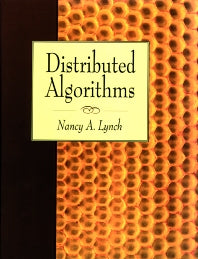Freshly Printed - allow 10 days lead
Couldn't load pickup availability
Distributed Algorithms
Nancy A. Lynch (Author)
9781558603486, Elsevier Science
Hardback, published 16 April 1996
912 pages
23.4 x 19 x 4.4 cm, 1.64 kg
In Distributed Algorithms, Nancy Lynch provides a blueprint for designing, implementing, and analyzing distributed algorithms. She directs her book at a wide audience, including students, programmers, system designers, and researchers. Distributed Algorithms contains the most significant algorithms and impossibility results in the area, all in a simple automata-theoretic setting. The algorithms are proved correct, and their complexity is analyzed according to precisely defined complexity measures. The problems covered include resource allocation, communication, consensus among distributed processes, data consistency, deadlock detection, leader election, global snapshots, and many others. The material is organized according to the system model—first by the timing model and then by the interprocess communication mechanism. The material on system models is isolated in separate chapters for easy reference. The presentation is completely rigorous, yet is intuitive enough for immediate comprehension. This book familiarizes readers with important problems, algorithms, and impossibility results in the area: readers can then recognize the problems when they arise in practice, apply the algorithms to solve them, and use the impossibility results to determine whether problems are unsolvable. The book also provides readers with the basic mathematical tools for designing new algorithms and proving new impossibility results. In addition, it teaches readers how to reason carefully about distributed algorithms—to model them formally, devise precise specifications for their required behavior, prove their correctness, and evaluate their performance with realistic measures.
1 Introduction 2 Modelling I
Synchronous Network Model 3 Leader Election in a Synchronous Ring 4 Algorithms in General Synchronous Networks 5 Distributed Consensus with Link Failures 6 Distributed Consensus with Process Failures 7 More Consensus Problems 8 Modelling II: Asynchronous System Model 9 Modelling III: Asynchronous Shared Memory Model 10 Mutual Exclusion 11 Resource Allocation 12 Consensus 13 Atomic Objects 14 Modelling IV: Asynchronous Network Model 15 Basic Asynchronous Network Algorithms 16 Synchronizers 17 Shared Memory versus Networks 18 Logical Time 19 Global Snapshots and Stable Properties 20 Network Resource Allocation 21 Asynchronous Networks with Process Failures 22 Data Link Protocols 23 Partially Synchronous System Models 24 Mutual Exclusion with Partial Synchrony 25 Consensus with Partial Synchrony
Subject Areas: Computer architecture & logic design [UYF], Computer networking & communications [UT], Data encryption [URY], Data capture & analysis [UNC], Aerospace & aviation technology [TRP], Library, archive & information management [GLC]


